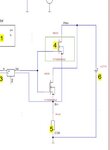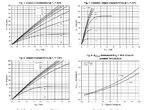Nizar_Ib
Member level 1
Hi,
I'm building a loader to test Power Supplies, I'm using two parallel mosfet's to work as a dynamic load where can change the Vgs to control the current.
I have two mosfet's (P'N: IXTK200N10L2), which are connected parallely. see the circuit below:

I have some questions:
1) do I need to connect a resistor in the gate?
2) how can I ensure balanced current on both transistors?
3) because of the fact that I have a very small current on the gate, is it important which cable gauge I must put on the gate>source?
I'm building a loader to test Power Supplies, I'm using two parallel mosfet's to work as a dynamic load where can change the Vgs to control the current.
I have two mosfet's (P'N: IXTK200N10L2), which are connected parallely. see the circuit below:

I have some questions:
1) do I need to connect a resistor in the gate?
2) how can I ensure balanced current on both transistors?
3) because of the fact that I have a very small current on the gate, is it important which cable gauge I must put on the gate>source?

